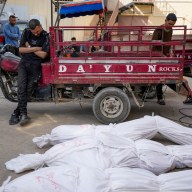Each year, the approximately 9 million U.S. households without bank accounts risk paying fees in the triple digits for money orders, check cashing and prepaid debit cards, while missing opportunities to earn interest on their savings. Although a new federal report shows that the so-called unbanked rate is declining, in seven states over 10% of households store their money off the grid. In 2015 across the U.S., 7% of households were unbanked, which means no memberhad a savings or checking account, according to the Federal Deposit Insurance Corp.’s National Survey of Unbanked and Underbanked Households released in October. That percentage is down from 7.7% in 2013 and 8.2% in 2011. Among states, the percentage of households without bank accounts range from well below to above the national rate. Vermont had the lowest percentage (1.5%) of households without bank accounts in 2015, while Louisiana had the highest rate (14%). Metro area data
The FDIC survey includes data for 68 large metro areas. Here are the 10 places with the highest number of unbanked households in 2015 and the percentage that didn’t have accounts:
– New Orleans-Metairie (17.4%)
2. Memphis, Tennessee (17.2%)
3. Baton Rouge, Louisiana (14.3%)
4. Oklahoma City (13.3%)
5. Jackson, Mississippi (12.5%)
5. Wichita, Kansas (12.5%)
7. Birmingham-Hoover, Alabama (12.3%)
8. San Antonio-New Braunfels (11.3%)
8. Tulsa, Oklahoma (11.3%)
10. Little Rock-North Little Rock-Conway, Arkansas (11.2%)
Key takeaways
More metro areas saw a decrease in unbanked rates than an increase. From 2013 to 2015, the percentage of households without bank accounts decreased in 35 metro areas, increased in 25 places and remained the same in one location, according to an FDIC data set of 61 metro areas. Some places saw significant drops. For example, the Phoenix-Mesa-Scottsdale metro area was home to the second-highest percentage of unbanked households (16.3%) in 2013. In two years, that rate fell to 10.6%. The Orlando-Kissimmee-Sanford, Florida, metro area also saw a drop in the percentageof unbanked residents — from 9.9% of households in 2013 to 4.3% in 2015. Some cities bucked the trend and saw increases. In some places, the percentage of unbanked households significantly increased. The Austin-Round Rock, Texas, metro area went from having one of the lowest percentages of unbanked households in 2013 (1.3%) to an above-average rate of 8.6% in 2015. And while the Birmingham-Hoover, Alabama, metro area had one of the highest rates of unbanked households in 2015 at 12.3%, just two years ago, it had a below-average 5.7%. Statewide, the percentage of households in Alabama without bank accounts increased from 9.2% in 2013 to 12.5% in 2015. Unbanked rates are highest in the South. In 2015, the states with the highest percentage of unbanked households were in the South. As well, nine of the 10 metro areas with the highest 2015 unbanked rates were in the South. Costs of not having bank accounts
Unbanked households in the South and elsewhere must rely on bank alternatives, such as payday lending stores and retailers to cash checks and buy money orders. A recent NerdWallet study found that households dealing only in cash pay average annual costs of $198.83 for check cashing and money orders. Unbanked households with prepaid debit cards that allow direct deposit pay an annual average of $196.50 in fees, the analysis determined, while those with prepaid debit cards without direct deposit pay $497.33. For those who use banks, the average checking account costs about $150 a year, the study found. This estimate includes monthly maintenance charges and two overdraft fees. Some accounts, which have lower overdraft fees and no monthly charges, cost customers about $30 annually. Families that don’t use financial institutions also miss out on savings accounts, a useful way to build emergency funds, and credit cards that can help build credit. They also don’t benefit from the full range of fraud protections that federally insured banks and credit unions offer, and they can’t access online and mobile banking tools that help save time and money. Laura McMullen is a staff writer at NerdWallet, a personal finance website. Email: lmcmullen@nerdwallet.com. Twitter: @lauraemcmullen. Sreekar Jasthi is a data analyst at NerdWallet. Email: sreekar@nerdwallet.com. The article Here’s Where People Are Off the Banking Grid originally appeared on NerdWallet.
















